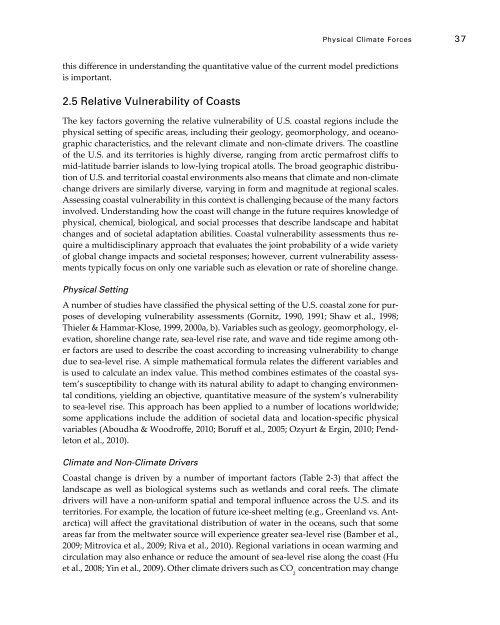Coastal Impacts, Adaptation, and Vulnerabilities - Climate ...
Coastal Impacts, Adaptation, and Vulnerabilities - Climate ...
Coastal Impacts, Adaptation, and Vulnerabilities - Climate ...
Create successful ePaper yourself
Turn your PDF publications into a flip-book with our unique Google optimized e-Paper software.
Physical <strong>Climate</strong> Forces 37this difference in underst<strong>and</strong>ing the quantitative value of the current model predictionsis important.2.5 Relative Vulnerability of CoastsThe key factors governing the relative vulnerability of U.S. coastal regions include thephysical setting of specific areas, including their geology, geomorphology, <strong>and</strong> oceanographiccharacteristics, <strong>and</strong> the relevant climate <strong>and</strong> non-climate drivers. The coastlineof the U.S. <strong>and</strong> its territories is highly diverse, ranging from arctic permafrost cliffs tomid-latitude barrier isl<strong>and</strong>s to low-lying tropical atolls. The broad geographic distributionof U.S. <strong>and</strong> territorial coastal environments also means that climate <strong>and</strong> non-climatechange drivers are similarly diverse, varying in form <strong>and</strong> magnitude at regional scales.Assessing coastal vulnerability in this context is challenging because of the many factorsinvolved. Underst<strong>and</strong>ing how the coast will change in the future requires knowledge ofphysical, chemical, biological, <strong>and</strong> social processes that describe l<strong>and</strong>scape <strong>and</strong> habitatchanges <strong>and</strong> of societal adaptation abilities. <strong>Coastal</strong> vulnerability assessments thus requirea multidisciplinary approach that evaluates the joint probability of a wide varietyof global change impacts <strong>and</strong> societal responses; however, current vulnerability assessmentstypically focus on only one variable such as elevation or rate of shoreline change.Physical SettingA number of studies have classified the physical setting of the U.S. coastal zone for purposesof developing vulnerability assessments (Gornitz, 1990, 1991; Shaw et al., 1998;Thieler & Hammar-Klose, 1999, 2000a, b). Variables such as geology, geomorphology, elevation,shoreline change rate, sea-level rise rate, <strong>and</strong> wave <strong>and</strong> tide regime among otherfactors are used to describe the coast according to increasing vulnerability to changedue to sea-level rise. A simple mathematical formula relates the different variables <strong>and</strong>is used to calculate an index value. This method combines estimates of the coastal system’ssusceptibility to change with its natural ability to adapt to changing environmentalconditions, yielding an objective, quantitative measure of the system’s vulnerabilityto sea-level rise. This approach has been applied to a number of locations worldwide;some applications include the addition of societal data <strong>and</strong> location-specific physicalvariables (Aboudha & Woodroffe, 2010; Boruff et al., 2005; Ozyurt & Ergin, 2010; Pendletonet al., 2010).<strong>Climate</strong> <strong>and</strong> Non-<strong>Climate</strong> Drivers<strong>Coastal</strong> change is driven by a number of important factors (Table 2-3) that affect thel<strong>and</strong>scape as well as biological systems such as wetl<strong>and</strong>s <strong>and</strong> coral reefs. The climatedrivers will have a non-uniform spatial <strong>and</strong> temporal influence across the U.S. <strong>and</strong> itsterritories. For example, the location of future ice-sheet melting (e.g., Greenl<strong>and</strong> vs. Antarctica)will affect the gravitational distribution of water in the oceans, such that someareas far from the meltwater source will experience greater sea-level rise (Bamber et al.,2009; Mitrovica et al., 2009; Riva et al., 2010). Regional variations in ocean warming <strong>and</strong>circulation may also enhance or reduce the amount of sea-level rise along the coast (Huet al., 2008; Yin et al., 2009). Other climate drivers such as CO2concentration may change
















